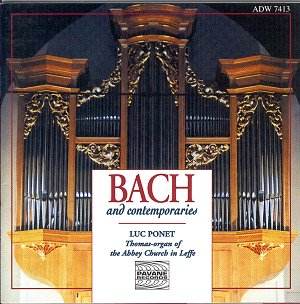The 1996 Thomas organ of the Abbey Church at Leffe
was built under the influence of Gottfried Silbermann, the famous Saxon
organ builder with whom J.S.Bach was in contact and collaboration. The
result is an organ that sounds authentically like an historical German
Baroque instrument. According to the builder, the acoustics of the Abbey
help the good reverberation - especially the low frequencies. The action
is mechanical and Ponet takes advantage of it by taking the melodic
lines nicely and clearly.
The selected programme has a very good variety of different
composers and pieces suitable for the Thomas organ. Johann Krieger was
one of the most highly esteemed composers of the middle German pre-Bach
generation. The Toccata in C is a very striking piece with virtuosic
passages and very regular rhythmic patterns whereas the fugues published
in 1960 by F.W. Riegel are actually a two-part composition. The Preludio-Ricercar-Fuga-Passacaglia
harnesses the form of suite and sonata and because of this Krieger could
possibly be ‘called a pioneer in the development of the later larger
musical forms’.
Kuhnau was an organist at the Thomaskirche from 1684
to 1701. His organ pieces are very charming; especially the Toccata
in A which is ‘an eloquent isolated composition in which the influence
of Froberger is not difficult to uncover’.
The Rudolph collection of works of J.S. Bach was discovered
in 1985. Stylistically they bear young Bach’s experimental ways of composition.
Fasch was a candidate together with Bach for the cantorate
of St Thomas. The trio sonata in c-moll was originally written for two
violins and continuo by Fasch and later transcribed for organ by Bach,
assembled together in BWV 585. This piece is ‘important as an example
of the ‘new art’ of the classical sonata and later symphony’.
Altnickol became organist in Niderwiesa and Naumburg
and he married one of Bach’s daughters from his second marriage. The
Ricercar is a complex composition based on the same theme of Bach’s
Fugue in C, BWV 545.
The CD notes are well presented but they also carry
typing mistakes.
Ponet’s playing is expertly efficient and musical with
well-articulated phrasing and sparkling ornaments, as well as an excellent
sense of rhythm. His selected registrations work very well all way through
and capture all the beauty of the pieces. The virtuosic passages of
Krieger’s and Kuhnau’s Toccatas are executed with accuracy, especially
the pedal ones. In general Ponet succeeds in projecting this not very
well-known music with appropriate mastery, majesty and sensitivity.
Christina Antoniadou

